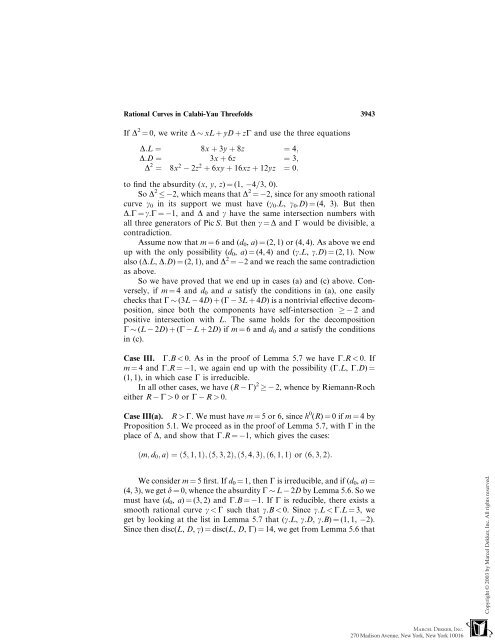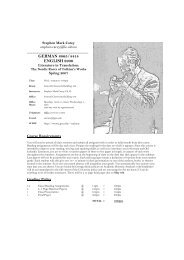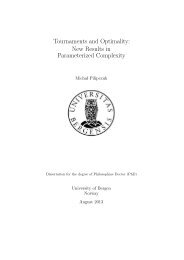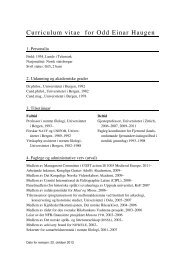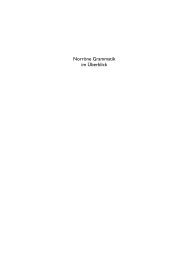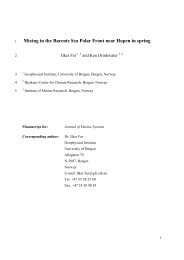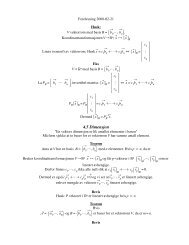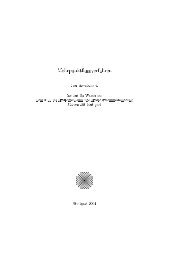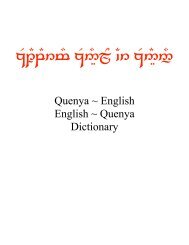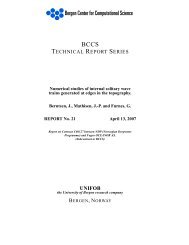Rational Curves in Calabi-Yau Threefolds
Rational Curves in Calabi-Yau Threefolds
Rational Curves in Calabi-Yau Threefolds
You also want an ePaper? Increase the reach of your titles
YUMPU automatically turns print PDFs into web optimized ePapers that Google loves.
<strong>Rational</strong> <strong>Curves</strong> <strong>in</strong> <strong>Calabi</strong>-<strong>Yau</strong> <strong>Threefolds</strong> 3943<br />
If D 2 ¼ 0, we write D xL þ yD þ zG and use the three equations<br />
D:L ¼ 8x þ 3y þ 8z ¼ 4;<br />
D:D ¼ 3x þ 6z ¼ 3;<br />
D 2 ¼ 8x 2 2z 2 þ 6xy þ 16xz þ 12yz ¼ 0:<br />
to f<strong>in</strong>d the absurdity (x, y, z) ¼ (1, 4=3, 0).<br />
So D 2<br />
2, which means that D 2 ¼ 2, s<strong>in</strong>ce for any smooth rational<br />
curve g0 <strong>in</strong> its support we must have (g0.L, g0.D) ¼ (4, 3). But then<br />
D.G ¼ g.G ¼ 1, and D and g have the same <strong>in</strong>tersection numbers with<br />
all three generators of Pic S. But then g ¼ D and G would be divisible, a<br />
contradiction.<br />
Assume now that m ¼ 6 and (d0, a) ¼ (2, 1) or (4, 4). As above we end<br />
up with the only possibility (d0, a) ¼ (4, 4) and (g.L, g.D) ¼ (2, 1). Now<br />
also (D.L, D.D) ¼ (2, 1), and D 2 ¼<br />
as above.<br />
2 and we reach the same contradiction<br />
So we have proved that we end up <strong>in</strong> cases (a) and (c) above. Conversely,<br />
if m ¼ 4 and d0 and a satisfy the conditions <strong>in</strong> (a), one easily<br />
checks that G (3L 4D) þ (G 3L þ 4D) is a nontrivial effective decomposition,<br />
s<strong>in</strong>ce both the components have self-<strong>in</strong>tersection 2 and<br />
positive <strong>in</strong>tersection with L. The same holds for the decomposition<br />
G (L 2D) þ (G L þ 2D) ifm¼6andd0and a satisfy the conditions<br />
<strong>in</strong> (c).<br />
Case III. G.B < 0. As <strong>in</strong> the proof of Lemma 5.7 we have G.R < 0. If<br />
m ¼ 4 and G.R ¼ 1, we aga<strong>in</strong> end up with the possibility (G.L, G.D) ¼<br />
(1, 1), <strong>in</strong> which case G is irreducible.<br />
In all other cases, we have (R G) 2<br />
2, whence by Riemann-Roch<br />
either R G > 0orG R > 0.<br />
Case III(a). R > G. We must have m ¼ 5 or 6, s<strong>in</strong>ce h 0 (R) ¼ 0ifm ¼ 4by<br />
Proposition 5.1. We proceed as <strong>in</strong> the proof of Lemma 5.7, with G <strong>in</strong> the<br />
place of D, and show that G.R ¼ 1, which gives the cases:<br />
ðm; d0; aÞ ¼ð5; 1; 1Þ; ð5; 3; 2Þ; ð5; 4; 3Þ; ð6; 1; 1Þ or ð6; 3; 2Þ:<br />
We consider m ¼ 5 first. If d0 ¼ 1, then G is irreducible, and if (d0, a) ¼<br />
(4, 3), we get d ¼ 0, whence the absurdity G L 2D by Lemma 5.6. So we<br />
must have (d0, a) ¼ (3, 2) and G.B ¼ 1. If G is reducible, there exists a<br />
smooth rational curve g < G such that g.B < 0. S<strong>in</strong>ce g.L < G.L ¼ 3, we<br />
get by look<strong>in</strong>g at the list <strong>in</strong> Lemma 5.7 that (g.L, g.D, g.B) ¼ (1, 1, 2).<br />
S<strong>in</strong>ce then disc(L, D, g) ¼ disc(L, D, G) ¼ 14, we get from Lemma 5.6 that


